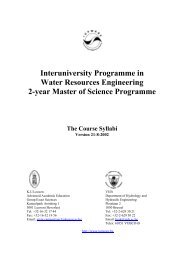CFHT operating manual - Homepage Usask
CFHT operating manual - Homepage Usask
CFHT operating manual - Homepage Usask
You also want an ePaper? Increase the reach of your titles
YUMPU automatically turns print PDFs into web optimized ePapers that Google loves.
ESPaDOnS: data reduction routines http://webast.ast.obs-mip.fr/magnetisme/espadons_new/reduction.html<br />
ESPaDOnS<br />
data reduction routines<br />
Libre-ESpRIT: a dedicated data reduction package<br />
ESpRIT is a data reduction package developed specifically for reducing echelle spectropolarimetric data. Developed in 1995 by<br />
Donati et al. (1997, MNRAS 291, 658), it implements the main principles of optimal extraction as devised by Horne (1986, PASP<br />
98, 609) and further revised by Marsh (1989, PASP 101, 1032), but generalised to retrieve polarimetric information from echelle<br />
spectra with curved orders and tilted slits. ESpRIT was extensively used in the last decade to extract spectropolarimetric and<br />
spectroscopic data secured with the 3.9m Anglo-Australian Telescope (equipped with the ucles spectrograph and the sempol<br />
polarimeter) or with the 2m Bernard Lyot Telescope (equipped with the MuSiCoS spectropolarimeter).<br />
ESpRIT proceeds in 2 steps:<br />
the first step consists in performing a geometrical analysis from a sequence of calibration exposures; the position and<br />
shape of orders is derived from a mean flat field image while the the details of the wavelength to pixel relation along and<br />
across each spectral order is obtained from a comparison frame;<br />
the second step achieves spectrum optimal extraction in itself, using the geometrical information derived in step 1;<br />
spectra processed with ESpRIT include not only the flux and polarisation information, but also a check spectrum (to<br />
help identifying spurious polarisation signatures) and error bars at each wavelength point in the spectrum.<br />
Libre-ESpRIT is the new release of ESpRIT; in addition to being much more automated than its predecessor (the full<br />
calibration step is now performed automatically in a single command line), a number of new important features are now<br />
available (eg possibility of extracting tilted slit spectra on a grid with bins smaller than ccd pixels) and many critical operations<br />
(eg order tracking and order section profile determination) are significantly improved both for reliability and accuracy.<br />
As opposed to ESpRIT (distributed around at users’ request) and to avoid repeating the same errors twice, it has been decided<br />
that Libre-ESpRIT is not a free package (’Libre’ meaning here ’autonomous’ or ’independent from others’ rather than<br />
’available to others’); while the binary files will be operational at cfht for real time processing of ESPaDOnS data, observers<br />
will not be able to bring them back home and (ab)use them for other applications of their own, unless explicit written agreement<br />
under strict and predefined conditions is obtained before hand from the author.<br />
Geometrical calibration (step #1)<br />
As mentionned above, the first step starts with finding all<br />
orders present on the ccd and tracking them across their free<br />
spectral range (full length of order); the derived positions are<br />
then fitted by a 2d polynome (with a typical rms accuracy of<br />
better than 0.05pxl). The graphical result of this operation is<br />
shown on the right graph, where the estimated and fitted<br />
lateral shifts of the 40 orders with respect to their position at<br />
mid ccd are plotted as a function of row number (circles<br />
depicting measurements and lines representing the fit). The<br />
longest orders are the red ones (order number #22 and above),<br />
while the shortest orders are the blue ones (order #61 and<br />
below), the free spectral range of an order being inversely<br />
proportional to the order number. Note the difference in scale<br />
between both axes.<br />
The direction and shape of the slit formed by the image slicer<br />
at spectrograph entry is then evaluated across each order from<br />
a comparison frame (either a Th/Ar or a Fabry-Perot frame)<br />
and fitted by a low order 2d polynome depending on both<br />
order number and distance from order centre (for the slit<br />
direction) plus a multi-parametric shift function depending on<br />
1 of 2 08/07/04 11:33 PM

















